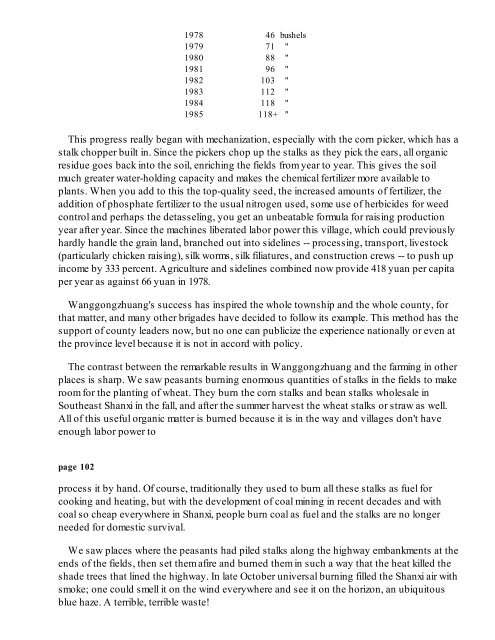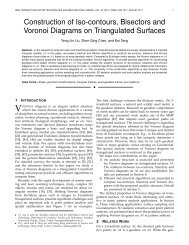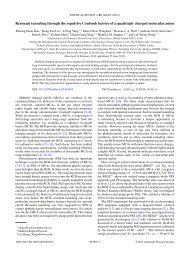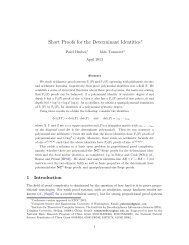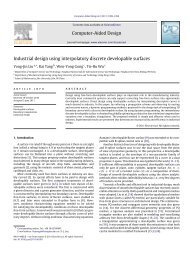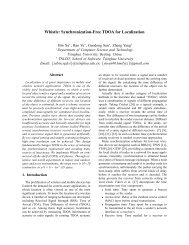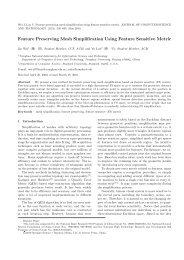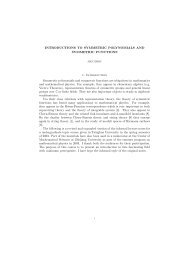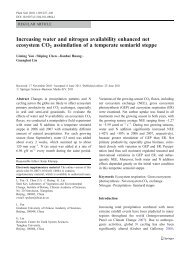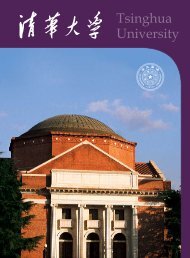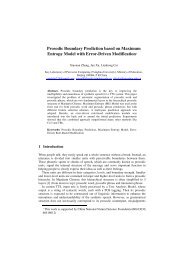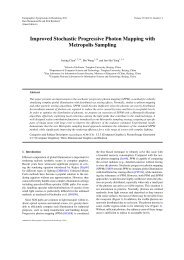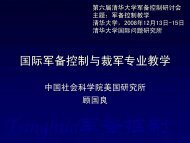<strong>1978</strong>197919801981198219831984198546718896103112118118+bushels"""""""This progress really began with mechanization, especially with the corn picker, which has astalk chopper built in. Since the pickers chop up the stalks as they pick the ears, all organicresidue goes back into the soil, enriching the fields from year to year. This gives the soilmuch greater water-holding capacity and makes the chemical fertilizer more available toplants. When you add to this the top-quality seed, the increased amounts <strong>of</strong> fertilizer, theaddition <strong>of</strong> phosphate fertilizer to the usual nitrogen used, some use <strong>of</strong> herbicides for weedcontrol and perhaps the detasseling, you get an unbeatable formula for raising productionyear after year. Since the machines liberated labor power this village, which could previouslyhardly handle the grain land, branched out into sidelines -- processing, transport, livestock(particularly chicken raising), silk worms, silk filiatures, and construction crews -- to push upincome by 333 percent. Agriculture and sidelines combined now provide 418 yuan per capitaper year as against 66 yuan in <strong>1978</strong>.Wanggongzhuang's success has inspired the whole township and the whole county, forthat matter, and many other brigades have decided to follow its example. This method has thesupport <strong>of</strong> county leaders now, but no one can publicize the experience nationally or even atthe province level because it is not in accord with policy.<strong>The</strong> contrast between the remarkable results in Wanggongzhuang and the farming in otherplaces is sharp. We saw peasants burning enormous quantities <strong>of</strong> stalks in the fields to makeroom for the planting <strong>of</strong> wheat. <strong>The</strong>y burn the corn stalks and bean stalks wholesale inSoutheast Shanxi in the fall, and after the summer harvest the wheat stalks or straw as well.All <strong>of</strong> this useful organic matter is burned because it is in the way and villages don't haveenough labor power topage 102process it by hand. Of course, traditionally they used to burn all these stalks as fuel forcooking and heating, but with the development <strong>of</strong> coal mining in recent decades and withcoal so cheap everywhere in Shanxi, people burn coal as fuel and the stalks are no longerneeded for domestic survival.We saw places where the peasants had piled stalks along the highway embankments at theends <strong>of</strong> the fields, then set them afire and burned them in such a way that the heat killed theshade trees that lined the highway. In late October universal burning filled the Shanxi air withsmoke; one could smell it on the wind everywhere and see it on the horizon, an ubiquitousblue haze. A terrible, terrible waste!
Since privatization all the traditional threshing floors have turned out to be too small. Everyfamily must now have its own space so all the contracting peasants, if they live anywherenear a highway, bring their unthreshed grain to the road, lay it out on the pavement to bethrashed by the vehicles passing through, then dry the grain on the shoulder <strong>of</strong> the road.Peasants have always used roads this way, but never on such a massive scale. This Octoberwe literally traveled several kilometers at a time over crops to be threshed. At one point beanstalks wrapped on our drive shaft and jammed it and it took about an hour to cut ourselvesfree.<strong>The</strong> grain processed on the roads gets really dirty. Oil from the passing trucks, cars, andtractors, manure and urine from the horses and mules, tar from the blacktop underneath allcontaminate the grain. Governments at various levels have forbidden processing on the roadsagain and again, but it still goes on on an ever more massive scale. No one can control it. Tomake sufficient threshing floors to substitute for these road areas would further deplete theamount <strong>of</strong> cropland and no one is in favor <strong>of</strong> that. Collective threshing uses much less space;it's the private threshing that bursts all bounds.In north Shanxi we saw a county where privatization combined with good leadership hadled to a big expansion <strong>of</strong> the dairy industry. Shanyin now boasts 8,000 cows, most <strong>of</strong> themprivately owned but all descended from a 1,000-cow state herd that has been there for a longtime. In one village we found 500 cows -- two to a family, three to a family, one to a family --and each cow in milk can yield a pr<strong>of</strong>it <strong>of</strong> 2,000 yuan a year. <strong>The</strong> peasants raise corn and feedthe cows corn meal and chopped stalks (the grain ration has added nutrients from a localmill);page 103they milk and after each milking send their milk to a milk powder plant by bicycle twice a day.What a sight! All those people, young and old, on bicycles with plastic containers <strong>of</strong> milkstrapped on both sides <strong>of</strong> the rear wheel lining the roads on the way to the milk plant. <strong>The</strong>reis no question that sideline development is the way to go and dairy cows, at least for now, area pr<strong>of</strong>itable sideline. But the whole process leads to polarization and quite rapidly. Alreadythe biggest private dairy has thirty head while the average family has but one or two. Withthirty head you have to hire labor, at least one person for-every three or four cows.Everywhere we heard complaints about taxes and fees. <strong>The</strong> dairies were no exception. Itseems that the Light Industry Bureau has the right to levy fees on all non-crop productionregardless <strong>of</strong> origin, even if it makes no contribution toward setting up or managing theenterprise. For instance, as soon as you start to milk a cow a cent and a half <strong>of</strong> the 26 centsyou get per jin <strong>of</strong> milk goes to the Light industry Bureau as a management fee. Another centand a half goes in other taxes so three cents comes <strong>of</strong>f (almost 12 percent) before the milkeven reaches the plant. After that it is subject to various processing taxes, shipping taxes,and so on -- a real burden on the farming communities. People resent it and they are talkingabout it.
- Page 1 and 2:
THE GREATREVERSALThe Privatization
- Page 3 and 4:
This essence was known to many in C
- Page 5 and 6:
Introduction:China'sRuralReformsThe
- Page 7 and 8:
concern was, of course, the country
- Page 9 and 10:
I looked down in growing disbelief
- Page 11 and 12:
edefining what the word meant. Cert
- Page 13 and 14:
themselves, communists had, perforc
- Page 16 and 17:
It is against the background of Chi
- Page 18 and 19:
eformers. Throughout the whole cour
- Page 20 and 21:
in China. It emphasizes above all t
- Page 22 and 23:
Is Red," that solemn hymn to Mao Ze
- Page 24 and 25:
Hard work to transform the land was
- Page 26 and 27:
If meeting nonrelated young people
- Page 28 and 29: and three times elevated to top pos
- Page 30: can supply the raw material for lin
- Page 34 and 35: Construction Bureau who wanted to n
- Page 36 and 37: had already found wives and several
- Page 38 and 39: the peasants first gave support to
- Page 40 and 41: Zhanglaozhuang brigade, Ershihying
- Page 42 and 43: see Gaojen commune. There 7,300 abl
- Page 44 and 45: in 1978), (3) they planted large ar
- Page 46 and 47: can do so will others not denounce
- Page 48 and 49: destroyed all economies of scale an
- Page 50 and 51: The rejection of the above proposit
- Page 52 and 53: and was raising two pigs that she e
- Page 54 and 55: page 71in some of the new industrie
- Page 56 and 57: page 74Reformin Stride:Rural Change
- Page 58 and 59: authorities is that it automaticall
- Page 60 and 61: most promising things in the collec
- Page 62 and 63: than it contributes itself, it is a
- Page 64 and 65: mechanization plan could have done
- Page 66 and 67: page 86units, taking a mature sheep
- Page 68 and 69: measures are necessary.Since these
- Page 70 and 71: tremely hard to carry out. Most mea
- Page 72 and 73: 60,000 mou. This would make seasona
- Page 74 and 75: lock the gates at Qinghua and other
- Page 76 and 77: programs that discourage production
- Page 80 and 81: Peasants who opt for transport on t
- Page 82 and 83: policy. Yet they are much touted by
- Page 84 and 85: millions of mu of badly eroded slop
- Page 86 and 87: page 111culture must also be modern
- Page 88 and 89: The Problem of UnemploymentThe most
- Page 90 and 91: mechanization of the more advanced
- Page 92 and 93: tractor and/or implement tire that
- Page 94 and 95: difficult form of cooperation. Betw
- Page 96 and 97: In order to mechanize agriculture s
- Page 98 and 99: Today's reports credit reform at Da
- Page 100 and 101: were deducted from net income befor
- Page 102 and 103: trees that appear to be, if not aba
- Page 104 and 105: denounced by the central government
- Page 106 and 107: spirit of Dazhai's citizens and to
- Page 108 and 109: Ironic Lessons, Past and PresentIn
- Page 110 and 111: Mao'sRuralPoliciesRevisitedA questi
- Page 112 and 113: point frequently raised by the refo
- Page 114 and 115: page 145Furthermore, the state help
- Page 116 and 117: mechanisms rather than government d
- Page 118 and 119: tractors who leased collective ente
- Page 120 and 121: All this alarmed certain forces in
- Page 122 and 123: terthrusts over the years. All of t
- Page 124 and 125: exercises." Just as happened during
- Page 126 and 127: every region.In the fourth place, b
- Page 128 and 129:
preserve a strong collective core.
- Page 130 and 131:
Finally, China's independent nation
- Page 132 and 133:
The World Bank strategy of opening
- Page 134 and 135:
people. They want to transform the
- Page 136 and 137:
The reformers hoped and planned tha
- Page 138 and 139:
TiananmenMassacre:June 1989It's imp
- Page 140 and 141:
left, and then there would be a new
- Page 142 and 143:
the beginning of it. Once the army
- Page 144 and 145:
and I asked him why on earth he wen
- Page 146 and 147:
have been doing this work for many
- Page 148 and 149:
going to sweep everybody out, so th
- Page 150 and 151:
affront, as turmoil, as chaos, and


